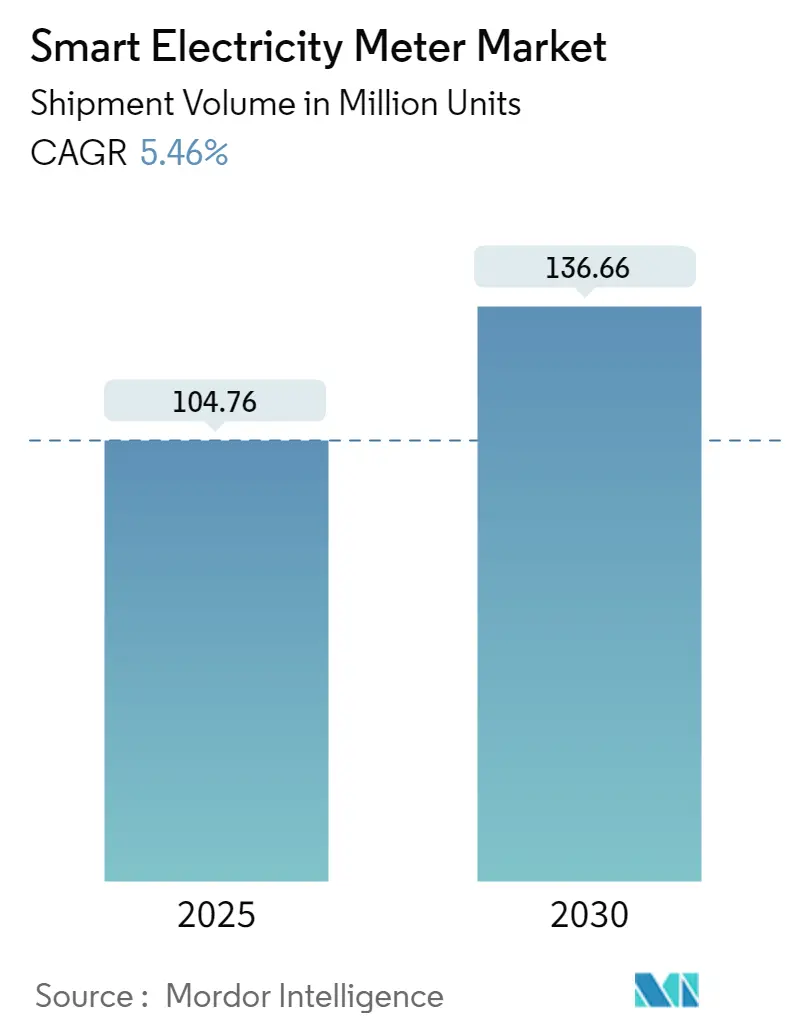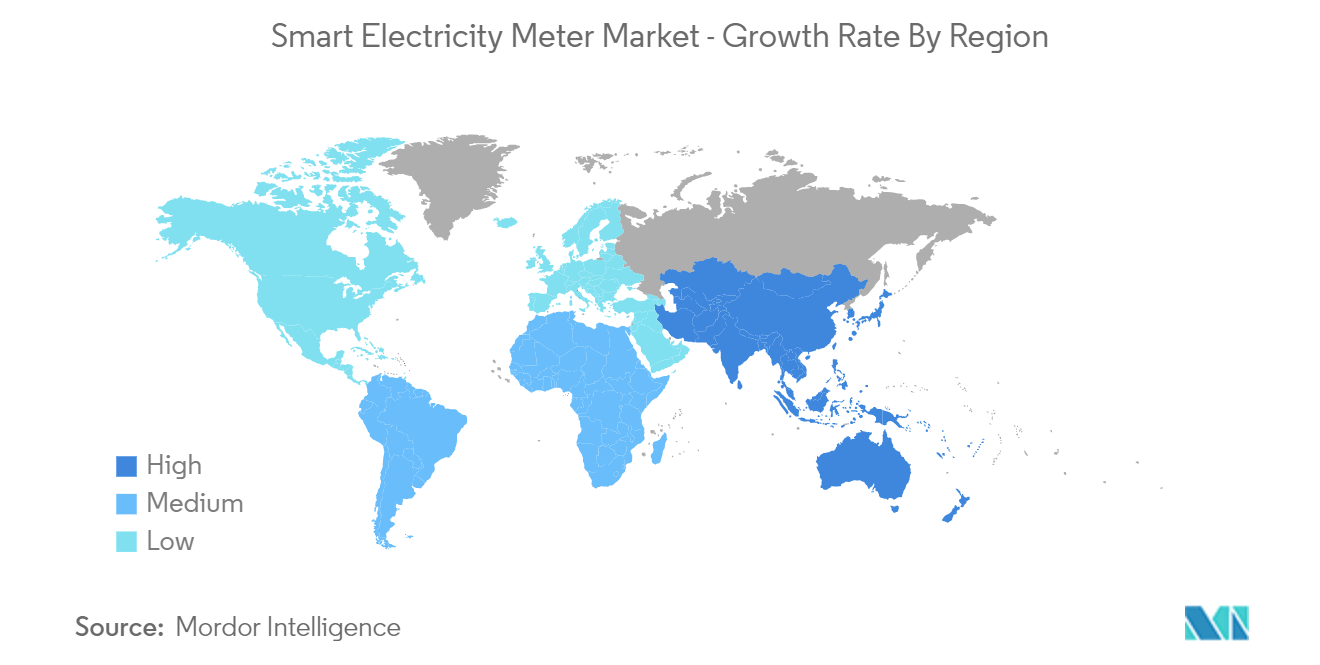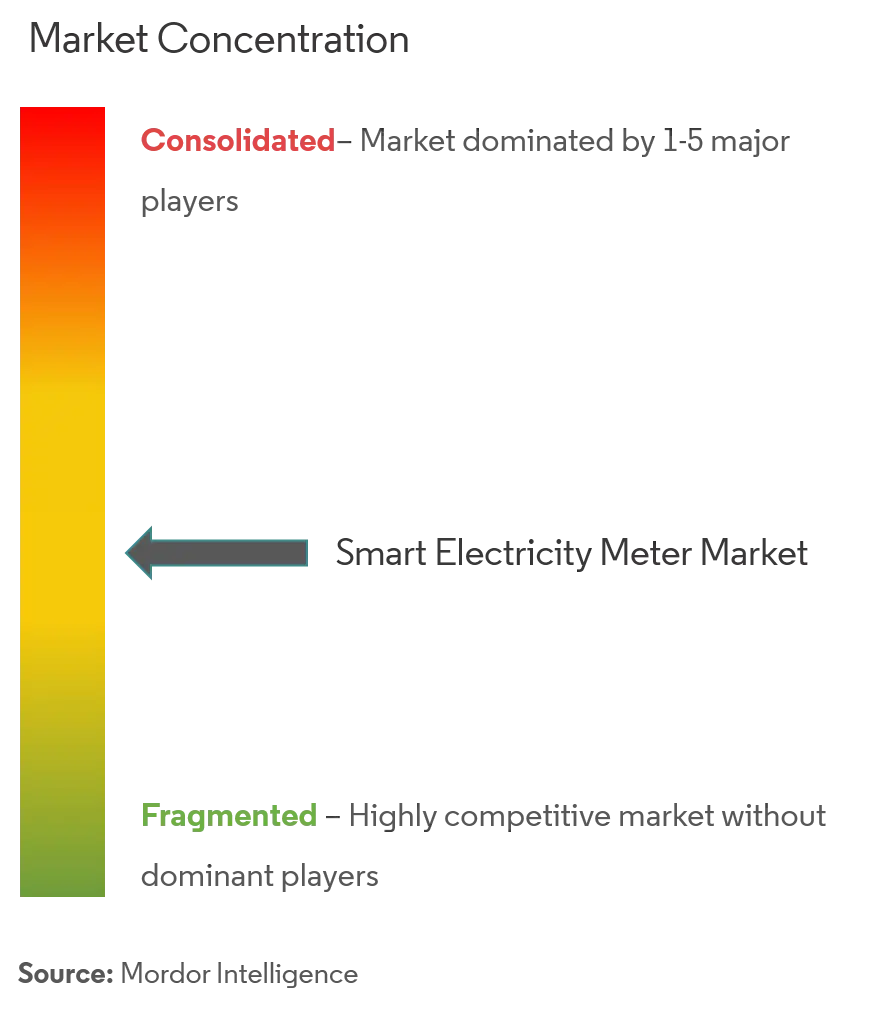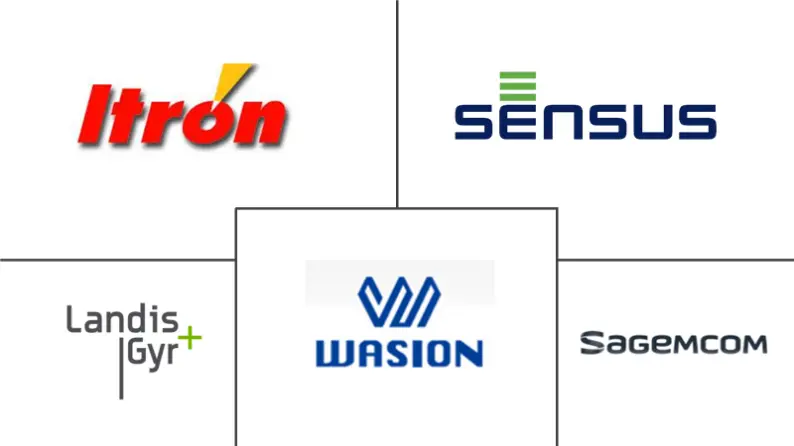
Smart Electricity Meter Market Analysis
The Smart Electricity Meter Market size in terms of shipment volume is expected to grow from 104.76 million units in 2025 to 136.66 million units by 2030, at a CAGR of 5.46% during the forecast period (2025-2030).
Smart meters deployment enabled the implementation of a Home Energy Management System (HEMS) or Building Energy Management System (BEMS) that allows visualization of the electric power usage in individual homes or entire buildings.
- Energy efficiency is increasingly becoming the primary focus globally, owing to the increasing economic activities, which led to high energy consumption rates and pushed global electricity grids to their limits. The global electricity generation in 2021 stood at 28,466 Terawatt-hours, according to BP.
- Digitization has been further accelerating and modernizing energy efficiency measures due to which the deployment of smart grids has been increasing globally, as they are capable of dynamically optimizing supply and fostering supply of large amounts of electricity from renewable energy sources, such as solar power.
- The recent COVID -19 outbreak and nationwide lockdown across the globe impacted the overall rollout of Smart meters globally. The global COVID -19 pandemic resulted in lockdowns in various parts of the world, which halted several operations across industries. As a result, the shipments and installations of smart meters were also affected.
- However, as the COVID-19 regulations are slowly being eased, the number of smart meters being installed is also expected to witness an increase in the long term. In many developed regions, most energy suppliers have been motivating their customers to upgrade to smart meters as it minimizes direct human interaction and offers several other benefits across the entire value chain, such as incentivizing energy conservation and facilitating easy bill payments, remote meter reading, improving billing and collection efficiency, reducing aggregate technical and commercial losses, and curbing power theft, among others.
- Consumer electronics, office equipment, and other plug loads consume nearly 15% to 20% of the total residential and commercial electricity while not in the primary mode. Most of this energy is consumed when they operate in low-power modes (even while they are not in use). Consumers are increasingly tending to install a smart energy management system to track such scenarios.
Smart Electricity Meter Market Trends
Residential Segment to Register Significant Growing
- Smart electric meter plays a significant role in the residential sector, as this meter measures the energy consumed by the consumers. The increasing smart grid investments and the surge in the rate of integration of renewable sources of power generation to the existing grids in developed economies are expected to support the growth of the smart electricity meter market.
- The meter measures the electricity consumption and communicates this to the central utility system. Globally, installations of these devices in the residential sector help in the reduction of CO2 emissions, owing to the increased consumer's inclination toward peak time savings of energy.
- The increasing residential construction activities and government mandates, like the EU 20-20-20 policy aiming to convert over 80% of the installed meter base to a smart one, have ensured growth prospects for the smart electricity meters market.
- Furthermore, as consumers move toward stand-alone energy generation systems, the interactive capacity of the Smart Grid will become more and more important. Rooftop solar electric systems and small wind turbines are now widely available and have become cost-effective for many homeowners and businesses. Installations of smart meters will help to effectively connect all these mini-power generating systems to the grid to help the overall power distribution and measurement process be effective and more efficient.
- Moreover, increasing urbanization and the increasing inclination toward the focus on developing urban lifestyles led to the expansion of deployment of smart home technologies and devices, which involves automatic control of electricity, light, and energy to avoid wastage. Hence, the increasing adoption of smart home devices and technologies across the homes globally is further expected to foster the growth in smart meters in the residential segment.

United States to Hold Significant Market Share
- The automatic meter reading solutions market has been reaching maturity in the United States, resulting in sluggish growth. Furthermore, according to the Institute for Electric Innovation in the United States, 115 million smart meters have been installed in the US by 2021.
- The replacement of first-generation meters and the shift to advanced metering infrastructure (with higher capabilities and improved technology) are expected to drive the smart electricity meters market in the future.
- Electric companies across the United States are leveraging smart meter data to monitor the health of the energy grid, restore electric service more quickly when outages occur, integrate distributed energy resources (DERs), and deliver energy services and solutions to customers. Furthermore, electricity companies in the United States are making significant investments to enhance the energy grid.
- Moreover, vendors in the region leveraging smart electric meters' potential by pairing them with additional tools, such as customer engagement tools and other incentive strategies, are expected to drive the adoption of smart electric meters in the market. For instance, Baltimore Gas and Electric enrolls its customers into its smart energy rewards program whenever the Smart electricity meter is installed. Customers receive feedback, peak time rebate incentives, and help reduce energy costs.
- Similarly, Pacific Gas & Electric, in the United States, reported AMI targeting a home retrofit program that delivers 3.5 times more energy savings in the targeted homes. Additionally, the integration of smart electric meters with technologies, such as data analytics, is expected to further foster the growth of the market studied in the region.

Smart Electricity Meter Industry Overview
The smart electricity meters market is moderately competitive and consists of several major players. The market is moderately fragmented, owing to the presence of many small and large players. These companies are leveraging strategic innovations and collaborative initiatives to increase their market share and increase their profitability. The companies operating in the market are also acquiring start-ups working on enterprise network equipment technologies to strengthen their product capabilities.
In October 2022, the power utilities of Andhra Pradesh announced a great up for rolling out a smart electricity meter project. The Union government decided to replace around 25 crore conventional meters with smart meters across India under the Smart Meter National Programme (SMNP).
Smart Electricity Meter Market Leaders
-
Itron, Inc.
-
Sensus USA Inc. (XYLEM INC)
-
Sagemcom SAS
-
Wasion Group Limited
-
Landis+gyr Group AG
- *Disclaimer: Major Players sorted in no particular order

Smart Electricity Meter Market News
- August 2022 - Adani Electricity Mumbai Limited (AEML) announced its plan to invest approximately INR 500 crore (~USD 60 million) to install smart meters in Mumbai, India. The company plans to install approximately seven lakh smart meters in the region by the end of 2023. The smart electricity meter of the company would enable the customers to get real-time updates on power consumption.
- April 2021 - Itron launched a new residential smart electricity meter for German utilities. The company developed a new eHZ-B smart meter with advanced functionality to help German cities and utilities advance the energy transition. In line with this acquisition, the company would be supporting the advanced metering infrastructure across Europe as per the German regulations in the market.
Smart Electricity Meter Industry Segmentation
Smart metering solutions comprise meters or modules with communication capabilities (either one-way or two-way) embedded within the meter or attached to the meter. They are used to collect and store data from the meters, which can be transmitted to handheld computers, mobile units, telephones, cellular, power line carriers, etc. The meter data can be used to optimize the operations by analyzing the stored interval data.
Smart Electricity Meter Market is segmented by End-user (Commercial, Residential, and Industrial), and Geography. The market sizes and forecasts are provided in terms of value (USD) for all the above segments.
| By End-user | Residential | ||
| Commercial | |||
| Industrial | |||
| By Geography | North America | United States | |
| Canada | |||
| Europe | United Kingdom | ||
| Spain | |||
| Germany | |||
| Italy | |||
| France | |||
| Turkey | |||
| Nordics | |||
| Benelux | |||
| Rest of Europe | |||
| Asia-Pacific | China | ||
| India | |||
| Japan | |||
| Australia and New Zealand | |||
| South Korea | |||
| Southeast Asia (Malaysia, Singapore, Thailand and Others) | |||
| Rest of Asia-Pacific | |||
| Latin America | Brazil | ||
| Mexico | |||
| Columbia | |||
| Chile | |||
| Rest of Latin America | |||
| Middle East & Africa | GCC | ||
| South Africa | |||
| Egypt | |||
| Rest of Africa | |||
| Rest of Middle East | |||
Smart Electricity Meter Market Research FAQs
How big is the Smart Electricity Meter Market?
The Smart Electricity Meter Market size is expected to reach 104.76 million units in 2025 and grow at a CAGR of 5.46% to reach 136.66 million units by 2030.
What is the current Smart Electricity Meter Market size?
In 2025, the Smart Electricity Meter Market size is expected to reach 104.76 million units.
Who are the key players in Smart Electricity Meter Market?
Itron, Inc., Sensus USA Inc. (XYLEM INC), Sagemcom SAS, Wasion Group Limited and Landis+gyr Group AG are the major companies operating in the Smart Electricity Meter Market.
Which is the fastest growing region in Smart Electricity Meter Market?
Asia Pacific is estimated to grow at the highest CAGR over the forecast period (2025-2030).
Which region has the biggest share in Smart Electricity Meter Market?
In 2025, the North America accounts for the largest market share in Smart Electricity Meter Market.
What years does this Smart Electricity Meter Market cover, and what was the market size in 2024?
In 2024, the Smart Electricity Meter Market size was estimated at 99.04 million units. The report covers the Smart Electricity Meter Market historical market size for years: 2019, 2020, 2021, 2022, 2023 and 2024. The report also forecasts the Smart Electricity Meter Market size for years: 2025, 2026, 2027, 2028, 2029 and 2030.
Our Best Selling Reports
Smart Power Meter Industry Report
Statistics for the 2025 Smart Electricity Meter market share, size and revenue growth rate, created by Mordor Intelligence™ Industry Reports. Smart Electricity Meter analysis includes a market forecast outlook for 2025 to 2030 and historical overview. Get a sample of this industry analysis as a free report PDF download.



